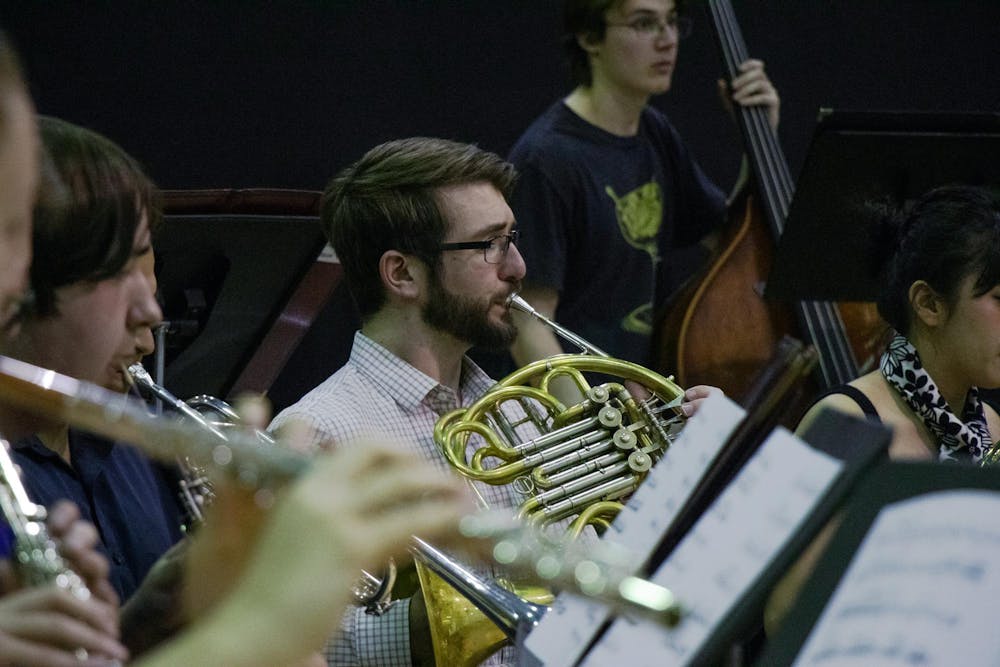The USC Wind Ensemble is looking to take audiences on a journey from the English Coast to the shores of France through three very different pieces of music in its upcoming concert on Monday.
The concert, titled "Both Sides of the Channel," is comprised of “Seascape” by English composer Ruth Gipps, "La Création du Monde" by French composer Darius Milhaud and “Concerto for Violin and Wind Orchestra” by German-American composer Kurt Weill.
Each piece has a different conductor, with graduate wind conducting student Cody Ray conducting “Seascape.” Ray compared the peice to a movie soundtrack, saying the music creates a narrative meant to evoke feelings of the sea in audiences.
“If you think about anything programmatic in nature, it’s just music that’s meant to portray an environment or music that's supposed to portray an image,” Ray said.
Ray said Gipps' visit to a seaside town named Broadstairs, England, was what sparked her connection with the sea, making it the driving inspiration behind the writing of “Seascape."
“While (Gipps) was there, she could feel the sea and the crashing of the waves on the shore,” Ray said. “A lot of that is happening in the music, you can hear the sound of the waves coming in and going out.”
The performance utilizes a wide array of instruments, including two flutes, two clarinets, two bassoons, two horns, an oboe and an English Horn. This creates a strong musical identity that Gipps felt reflected the sounds of the sea, Ray said.

A University of South Carolina student plays the bassoon during a wind ensemble rehearsal on March 21, 2024. The USC Wind Ensemble has been recognized for performances at state, regional and national conferences.
Graduate conducting student Kenneth Green will conduct the 1923 composition “La Création du Monde," which translates to “The Creation of the World." Director of Bands and Associate Professor of Music Cormac Cannon said the piece reflects the era it was written in.
“'La Création du Monde' has a lot of influences of jazz music in it — jazz from the '20s,” Cannon said.
The variety in musical style and smaller ensembles will make the concert exciting for audiences, Cannon said.
“The three pieces are very different from each other, which I think makes for an exciting concert because there’s a lot of variety,” Cannon said. “They’re all for relatively small groups.”
To conclude the concert, “Concerto for Violin and Wind Orchestra” will be conducted by Cannon. Associate Professor of Violin and Violin Pedagogy Ari Streisfeld will perform a violin solo.
Cannon said the concerto is especially distinctive, being very tonally and harmonically different from the other two pieces, with an expressionist feel.
“The piece is extraordinarily difficult and virtuosic and really demonstrates Dr. Streisfeld's incredible technique,” Cannon said. "It's a piece that doesn't get performed much because of how complicated and challenging it is."
Streisfeld said he is well-prepared for the challenge after several months of studying the piece. It has a very different style and feel compared to the rest of the concert, capturing an interesting moment in Weill's career, he said.
“I don’t have to compete over a full orchestra. Although, the wind ensemble can make a pretty big sound regardless, so I still have to bring it here and there,” Streisfeld said. "It's a very different style, but if you know what you're listening for, it's actually here (he developed) elements that became his cabaret style."
Streisfeld said that strings are not normally part of wind ensemble concerts, usually only utilizing woodwinds and brass instruments, but that Cannon has embraced the use of strings for this concert, with a string quartet also being utilized for the ensemble portion of the concerto.
Streisfeld said that despite Weill’s overall popularity, this piece hasn't been played much compared to the rest of his work, becoming relatively obscure even among people he expected to be familiar with it.
“Many people I’ve talked to didn’t even know it (the concerto) existed,” Streisfeld said. “They were kind of surprised that this concerto exists, so they’re very excited to hear it.”
Ray said the smaller chamber music ensembles make individual performers stand out even more in comparison to the usual larger orchestras.
“On the stage of Koger Center, you’d probably see anywhere from 40 to 60 people on stage. So the pieces that we’re playing here is more intimate in the sense that it’s all chamber music,” Ray said. “It’s a lot of dependence on individual preparation.”
“Both Sides of the Channel” will be performed March 25 from 7:30 to 9:30 p.m. in the Darla Moore School of Business' Johnson Performance Hall. Admission is free for all audiences.

